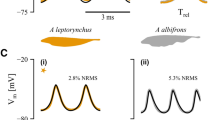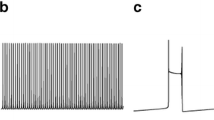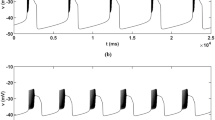Summary
-
1.
The connection between an interneuron initiating pacemaker activity in the bursting RPa1 neuron and the bursting neuron itself (Pin and Gola, 1983) has been analyzed in the snailHelix pomatia.
-
2.
Prolonged depolarization of the interneuronal membrane produced in it a series of action potentials as well as a parallel initiation or enhancement of bursting activity in the RPa1 neuron.
-
3.
If the discharge in the interneuron was evoked by short current pulses of threshold amplitude, no bursting activity was seen in the RPa1 neuron. However, short stimuli delivered on the background of subthreshold depolarization of the interneuronal membrane produced bursting activity in the RPa1 neuron.
-
4.
Under voltage-clamp conditions a slow inward current could be recorded in the RPa1 neuronal membrane after stimulation of the interneuron with a latency of about 2 sec. Short shifts of the holding potential in the hyperpolarizing direction at the maximum of this current produced a transient outward current.
-
5.
Replacement of extracellular Ca2+ by Mg2+ ions, as well as addition of 1 mM CdCl2 to the external solution, prevented the response to the interneuronal stimulation in the RPa1 neuron.
-
6.
Electron microscopic investigation of the interneuron has shown the abundance of Golgi complexes in its cytoplasm with electron-dense granules in their vicinity.
-
7.
It is concluded that the connection between the interneuron and the bursting neuron is of chemical origin, based on secretion by the former of some substances which activate at least two types of ionic channels in the membrane of the RPa1 neuron.
Similar content being viewed by others
References
Connor, J. A., and Hockberger, P. (1984). A novel membrane sodium current induced by injection of cyclic nucleotides into gastropod neurones.J. Physiol. (Lond.)354139–162.
Gorman, A. L. F., and Thomas, M. V. (1980). Intracellular calcium accumulation during depolarization in a molluscan neuron.J. Physiol. (Lond.)308258–285.
Ifshin, M. S., Gainer, H., and Barker, J. L. (1975). Peptide factor extracted from molluscan ganglia that modulates bursting pacemaker activity.Nature 25472–74.
Kononenko, N. I. (1978). Investigations of the ionic mechanisms of bursting activity inHelix pomatia neurons.Neurophysiology (Kiev) 10135–142.
Kononenko, N. I. (1979a). Modulation of the endogenous electrical activity of the bursting neuron in the snailHelix pomatia. I. The generator of the slow rhythms.Neuroscience 42037–2045.
Kononenko, N. I. (1979b). Modulation of the endogenous electrical activity of the bursting neuron in the snailHelix pomatia. II. The membrane characteristics related to modulation of the endogenous activity of the neuron.Neuroscience 42047–2054.
Kononenko, N. I. (1979c). Modulation of the endogenous electrical activity of the bursting neuron in the snailHelix pomatia. III. A factor modulating the endogenous electrical activity of the bursting neuron.Neuroscience 42055–2059.
Koval, L. M., Kononenko, N. I., and Skibo, G. G. (1984). The axosomatic contacts on the bursting neuron of the snailHelix pomatia. I. Ultrastructural features of the axosomatic contacts.Cell. Mol. Neurobiol. 431–41.
Krishtal, O. A. (1976). Blocking action of cadmium ions on calcium inward current in nerve-cell membrane.Dokl. Akad. Nauk SSSR 3211003–1006.
Pin, T., and Gola, M. (1983). Two identified interneurons modulate the firing pattern of pacemaker bursting cells inHelix.Neurosci. Lett. 37117–122.
Sakharov, D. A. (1974).The Genealogy of Neurons, Nauka, Moskva, p. 183 (Russian).
Smith, T. G., Jr., Barker, J. L., and Gainer, H. (1975). Requirements for bursting pacemaker potential activity in molluscan neurones.Nature 253450–452.
Wendelaar Bonga, S. E. (1970). Ultrastructure and histochemistry of neurosecretory cells and neurohaemal areas in the pond snailLymnaea stagnalis (L).Z. Zellforsch. 108190–225.
Zeimal, E. V., and Kachman, A. N. (1983). Furosemide blockage of the chloride conductance induced in mollusc neurons by acetylcholine orγ-aminobutyric acid.Neirofiziologiya (Kiev) 15589–595.
Author information
Authors and Affiliations
Rights and permissions
About this article
Cite this article
Kononenko, N.I., Osipenko, O.N. A study of the connection between the interneuron initiating pacemaker activity in a bursting neuron and the bursting neuron of the snailHelix pomatia . Cell Mol Neurobiol 6, 177–190 (1986). https://doi.org/10.1007/BF00711069
Received:
Revised:
Accepted:
Issue Date:
DOI: https://doi.org/10.1007/BF00711069




